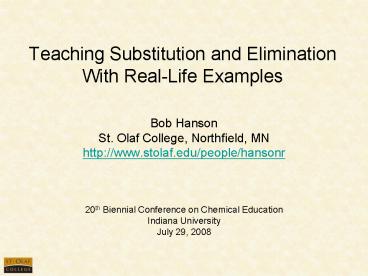Teaching Substitution and Elimination With Real-Life Examples PowerPoint PPT Presentation
Title: Teaching Substitution and Elimination With Real-Life Examples
1
Teaching Substitution and Elimination With
Real-Life Examples
- Bob Hanson
- St. Olaf College, Northfield, MN
- http//www.stolaf.edu/people/hansonr
- 20th Biennial Conference on Chemical Education
- Indiana University
- July 29, 2008
2
Road Map for This Presentation
- Background Data-Driven Chemistry
- The Course 1st Semester Organic
- The Data 39 reactions
- The Exam 25 questions
- Conclusions
3
Background Data-Driven Chemistry
generate data
analyze data
generate hypotheses
extrapolate hypotheses
4
Background Data-Driven Chemistry
- Start with raw data
- Transform the data into meaningful information
- Create a working model
R. M. Hanson, S. A. Bergman, "Data-Driven
Chemistry Making Molecular Models (Literally)
from Electron Diffraction Data, J. Chem. Educ.
1994, 150
5
Background focus on analysis
analyze data (identify trends)
generate data (experimental)
generate hypothesis (explain shapes and trends)
extrapolate hypothesis (predict shapes)
6
Application organic chemistry
analyze data (identify trends)
generate data (experimental)
generate hypothesis (explain reactions)
extrapolate hypothesis (predict reactions)
7
The Course
1st semester of a standard two-semester course 55
students in my section (approx. 120 students
total) 39 sophomores 13 juniors 3
seniors Textbook Paula Bruice, Organic
Chemistry, 5th ed.
8
(No Transcript)
9
(No Transcript)
10
(No Transcript)
11
Focus substitution and elimination
analyze data (identify trends)
generate data (experimental)
generate hypothesis (explain reactions)
extrapolate hypothesis (predict reactions)
12
Data Sources
Ingold, Structure and Mechanism in Organic
Chemistry, 2nd Ed., 1969 Compendium of Organic
Synthetic Methods, 1971 M March, Advanced
Organic Chemistry, 3rd Ed., 1985 V Vogel,
Textbook of Practical Organic Chemistry, 5th Ed.,
1989
13
The Data
14
The Data
15
The Data
16
The Data
17
The Data
18
The Data
19
The Data
20
The Data
21
The Data
22
The Data
23
The Exam
- 55 minutes
- 25 multiple-choice questions
- Instructions
- In each case, read each possible answer, use a
process of elimination, and circle the BEST
answer. If you are having trouble deciding
between two answers, briefly explain your final
choice. If you do so, use just a few words, just
to clue me in to what you are thinking. Do not
dwell on any particular problem for an extended
period of time. Each question is worth 2 points.
24
The Exam
25
The Exam
26
The Exam
27
The Exam
28
The Exam
29
The Exam
30
The Exam
31
The Exam
32
The Exam
33
The Exam
34
The Exam
35
The Exam
36
The Exam
37
The Exam
38
The Exam
39
The Exam
40
The Exam
average score 75 (average exam score for the
semester 73) three additional questions
41
The Exam
This test was (a) Easier than I thought it
would be. (b) Somewhat harder than I
thought it would be. (c) WAY harder than I
thought it would be.
42
The Exam
This test was (a) Easier than I thought it
would be. 15 (b) Somewhat harder than I
thought it would be. 14 (c) WAY harder than I
thought it would be. 1 (d) Maybe a bit
harder. 1 (e) About as hard as
expected. 16 (f) Not too bad.
1
43
The Exam
I think looking at the data this way is
GREAT, I learned a lot! seems to apply to
the real world more so than
the book. makes for an interesting way of
learning about these
reactions. really works with the way I
think. I liked it a lot!
44
The Exam
I think looking at the data this way is
GREAT, I learned a lot! seems to apply to
the real world more so than
the book. makes for an interesting way of
learning about these
reactions. really works with the way I
think. I liked it a lot! you can see and
think through all parts of the
reaction, doesnt feel as much like memorization
and regurgitation of infoyou
can think through why an
answer is right or wrong in comparison with
others.
45
Conclusions 1/3
- For the most part, students got it.
- Generally, students did not have trouble with
the - definitions of SN1, SN2, E1, and E2.
- A significant number of the students were still
having - trouble identifying strong and weak bases.
46
Conclusions 2/3
- Stereochemical concepts and notation were
integrated - into 6 of the 25 questions (24). For these
questions, 77 - of the responses were correct.
- However, proper axial/equatorial analysis was
critical - for 4 of those 6 questions, and for those, the
average was - somewhat lower 68.
47
Conclusions 3/3
- Using a data-driven approach can work in organic
chemistry. - Students rise to the challenge of guided
inquiry. - Substitution and Elimination are still difficult
concepts!
48
Thank you! This presentation is available
at http//www.stolaf.edu/depts/chemistry/bh/bcce2
0

